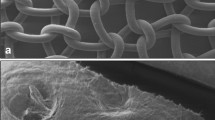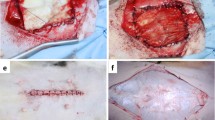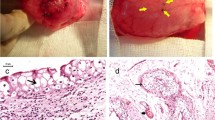Abstract
Introduction and hypothesis
To assess the biomechanical properties of full-thickness abdominal wall defects, either using Native tissues, with or without Overlay, and by substitution of the Defect by small intestinal submucosa mesh.
Methods
Seventy-two rats were divided into three groups according to repair method (Native, Overlay or Defect). At 7, 14, 30, and 90 days, six rats were sacrificed to measure tensile strength, collagen ingrowth, and host response.
Results
Explants had comparable strength at 30 days, the majority rupturing at the interface. Afterwards, the Native group was more resistant than both small intestine submucosa (SIS) groups with a more organized fibrotic scar on histology at 90 days.
Conclusions
SIS augmentation of native tissue repair does not increase strength. Replacement of abdominal wall by SIS is equally strong when compared to the SIS-augmented group; however, materials preferably rupture at the site of the implant itself.


Similar content being viewed by others
References
Birch C, Fynes MM (2002) The role of synthetic and biological prostheses in reconstructive pelvic floor surgery. Curr Opin Obstet Gynecol 14:527–535
De Ridder D (2008) Should we use meshes in the management of vaginal prolapse. Curr Opin Urol 18:377–382
Winters JC (2006) InteXen tissue processing and laboratory study. Int Urogynecol J Pelvic Floor Dysfunct 17 Suppl 1:S34–S38
Badylak SF (2004) Xenogeneic extracellular matrix as a scaffold for tissue reconstruction. Transpl Immunol 12:367–377
Schwandner O, Stadler F, Dietl O, Wirsching RP, Fuerst A (2008) Initial experience on efficacy in closure of cryptoglandular and Crohn’s transsphincteric fistulas by the use of the anal fistula plug. Int J Colorectal Dis 23:319–324
Badylak SF, Coffey AC, Lantz GC, Tacker WA, Geddes LA (1994) Comparison of the resistance to infection of intestinal submucosa arterial autografts versus polytetrafluoroethylene arterial prostheses in a dog model. J Vasc Surg 19:465–472
Helton WS, Fisichella PM, Berger R, Horgan S, Espat NJ, Abcarian H (2005) Short-term outcomes with small intestinal submucosa for ventral abdominal hernia. Arch Surg 140:549–560 (discussion, 560–562)
Jones JS, Rackley RR, Berglund R, Abdelmalak JB, DeOrco G, Vasavada SP (2005) Porcine small intestinal submucosa as a percutaneous mid-urethral sling: 2-year results. BJU Int 96:103–106
Chaliha C, Khalid U, Campagna L, Digesu GA, Ajay B, Khullar V (2006) SIS graft for anterior vaginal wall prolapse repair–a case-controlled study. Int Urogynecol J Pelvic Floor Dysfunct 17:492–497
Alponat A, Lakshminarasappa SR, Yavuz N, Goh PM (1997) Prevention of adhesions by Seprafilm, an absorbable adhesion barrier: an incisional hernia model in rats. Am Surg 63:818–819
Claerhout F, Verbist G, Verbeken E, Konstantinovic M, De Ridder D, Deprest J (2008) Fate of collagen-based implants used in pelvic floor surgery: a 2-year follow-up study in a rabbit model. Am J Obstet Gynecol 198(94):e1–e6
Konstantinovic ML, Lagae P, Zheng F, Verbeken EK, De Ridder D, Deprest JA (2005) Comparison of host response to polypropylene and non-cross-linked porcine small intestine serosal-derived collagen implants in a rat model. Bjog 112:1554–1560
Weber AM, Buchsbaum GM, Chen B et al (2004) Basic science and translational research in female pelvic floor disorders: proceedings of an NIH-sponsored meeting. Neurourol Urodyn 23:288–301
Deprest J, Zheng F, Konstantinovic M et al (2006) The biology behind fascial defects and the use of implants in pelvic organ prolapse repair. Int Urogynecol J Pelvic Floor Dysfunct 17:16–25
Maher C, Baessler K, Glazener CM, Adams EJ, Hagen S (2008) Surgical management of pelvic organ prolapse in women: a short version Cochrane review. Neurourol Urodyn 27:3–12
Toosie K, Gallego K, Stabile BE, Schaber B, French S, de Virgilio C (2000) Fibrin glue reduces intra-abdominal adhesions to synthetic mesh in a rat ventral hernia model. Am Surg 66:41–45
Badylak S, Kokini K, Tullius B, Simmons-Byrd A, Morff R (2002) Morphologic study of small intestinal submucosa as a body wall repair device. J Surg Res 103:190–202
Konstantinovic ML, Pille E, Malinowska M, Verbeken E, De Ridder D, Deprest J (2006) Tensile strength and host response towards different polypropylene implant materials used for augmentation of fascial repair in a rat model. Int Urogynecol J Pelvic Floor Dysfunct 18:619–626
Movat HZ (1955) Demonstration of all connective tissue elements in a single section; pentachrome stains. AMA Arch Pathol 60:289–295
Zheng F, Lin Y, Verbeken E et al (2004) Host response after reconstruction of abdominal wall defects with porcine dermal collagen in a rat model. Am J Obstet Gynecol 191:1961–1970
Zheng F, Verbeken E, de Ridder D, Deprest J (2005) Improved surgical outcome by modification of porcine dermal collagen implant in abdominal wall reconstruction in rats. Neurourol Urodyn 24:362–368
Spelzini F, Konstantinovic ML, Guelinckx I et al (2006) Tensile strength and host response towards silk and type I polypropylene implants used for augmentation of fascial repair in a rat model. Gynecol Obstet Invest 63:155–162
Damoiseaux JG, Dopp EA, Calame W, Chao D, MacPherson GG, Dijkstra CD (1994) Rat macrophage lysosomal membrane antigen recognized by monoclonal antibody ED1. Immunology 83:140–147
Ko R, Kazacos EA, Snyder S, Ernst DM, Lantz GC (2006) Tensile strength comparison of small intestinal submucosa body wall repair. J Surg Res 135:9–17
Clarke KM, Lantz GC, Salisbury SK, Badylak SF, Hiles MC, Voytik SL (1996) Intestine submucosa and polypropylene mesh for abdominal wall repair in dogs. J Surg Res 60:107–14
Badylak S, Kokini K, Tullius B, Whitson B (2001) Strength over time of a resorbable bioscaffold for body wall repair in a dog model. J Surg Res 99:282–287
Badylak SF (2007) The extracellular matrix as a biologic scaffold material. Biomaterials 28:3587–3593
Hilger WS, Walter A, Zobitz ME, Leslie KO, Magtibay P, Cornella J (2006) Histological and biomechanical evaluation of implanted graft materials in a rabbit vaginal and abdominal model. Am J Obstet Gynecol 195:1826–1831
Stone HH, Fabian TC, Turkleson ML, Jurkiewicz MJ (1981) Management of acute full-thickness losses of the abdominal wall. Ann Surg 193:612–618
Conflicts of interest
None.
Author information
Authors and Affiliations
Corresponding author
Rights and permissions
About this article
Cite this article
Ozog, Y., Konstantinovic, M.L., Verschueren, S. et al. Experimental comparison of abdominal wall repair using different methods of enhancement by small intestinal submucosa graft. Int Urogynecol J 20, 435–441 (2009). https://doi.org/10.1007/s00192-008-0793-6
Received:
Accepted:
Published:
Issue Date:
DOI: https://doi.org/10.1007/s00192-008-0793-6




